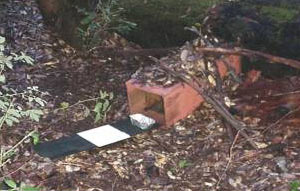Tracking Rare Mammals on MRC Lands
(Last Updated 9/5/2002)
Several species of mammals exist on MRC lands that are rarely seen or observed. These species include the American marten (Martes Americana), Pacific fisher (Martes pennanti pacifica), mountain lion (Felis concolor), bobcat (Felis rufus), and ringtail (Bassariscus astutus). These species are predators and mostly active at night. They are also secretive and shy and hence are difficult to observe.
To track these animals, MRC has developed an incidental wildlife sighting (IWS) database in which all MRC staff can enter rare wildlife sightings, locations, and details of the sighting. To date, this database has led to 32 sightings of bobcats, 21 sightings of black bears, 13 sightings of mountain lions, 3 sightings of red fox, and 1 sighting of Pacific fisher. Some sightings may indicate use of MRC property, and some may need to be confirmed with further specific evidence.
Although it is clear that MRC has bobcats, black bears, mountain lions, and foxes on the property, the presence of other rare mammals is still uncertain. The IWS database will not provide all the data needed to determine presence and distribution of rare mammals on MRC lands. In order to examine presence and distribution of these species, MRC will use sampling methods involving sooted track plates or infrared-triggered camera systems.

A sooted track plate pulled out of its protective wooden box (above) and prints left behind on contact paper (below).

Most mammals leave a print that is easily identifiable when stepping in soft substrates. These prints are also identifiable when mammals have stepped into something (such as soot) that will leave behind a print on a white background. A sooted track plate has an aluminum sheet covered by soot at the front and contact paper in the back. The animal is baited onto the plate with fish or chicken located behind the soot and contact paper. The plate is placed inside a wooden box to ensure that only species that attempt to get the bait are recorded. This is a simple and cost-effective technique to assess the presence or absence of rare mammals, such as the Pacific fisher or American marten.
Although sooted track plates are a cost-effective method for assessing the presence or absence of rare mammals, these species may visit track plates and not be identified. Also, large mammals such as black bears and mountain lions are not accounted for when using track plates. Another option to track rare mammals is to use infrared-triggered camera systems. When fully functional, an infrared-triggered system is unlikely to miss an approaching rare mammal. The drawback to these systems is that they require many electronic components that function simultaneously and thus require more maintenance than track plates.
Previously, MRC staff conducted a rare mammal survey using sooted track plates in Elk and Greenwood Creeks. Although no fishers or martens were detected, MRC continues to maintain data on incidental wildlife sightings and will conduct further rare mammal surveys in the future.